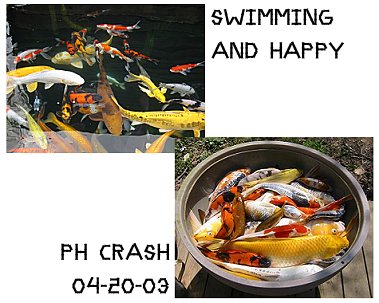
pH I
pH in The Most Basic Terms – by Doc Johnson
Simple drop type test with Bromthymol Blue
Stay above pH 7.0 for best results with Koi
 pH can “crash” to 5.5 overnight due to fish, plant and bacterial activity without adequate buffering of water – fatalities result
pH can “crash” to 5.5 overnight due to fish, plant and bacterial activity without adequate buffering of water – fatalities result
Baking Soda is a good buffer. Check Total Alkalinity before its use, though. (Use one teaspoon per ten gallons if the TA <100)
pH is a measurement of the free hydrogen ions in the system.
pH is measured on a scale of 1 to 14, but the pH required for life lies between 5.5 and 8.5.
Individual species will have varying demands as far as pH. Ignorance of the requirements of each species will result in the death of the animal in question.
pH impacts fish in several ways.
First, if the pH is too low, a condition within the fish called “Acidosis” results.
Symptoms are anorexia, and then production of excess slime, isolation, and resting on the bottom, finally, streaking of the fins, and death will occur.
If the pH is too high, the fish will produce excess slime, and will gasp at the surface. Losses can be major. “Alkalosis” is hard to reverse once it occurs.
On the other hand, Acidosis is rapidly corrected once the pH is brought up to a suitable range.
IMPORTANT: pH contributes to the toxicity of Ammonia.
At higher pH values, ammonia is more toxic.
Below pH 7.2 most Ammonia is ionized to “Ammonium” and is far less toxic.
This has relevance if you are considering raising the pH in a system with accumulating ammonias.
There is a routine, inexpensive test that measures pH, and compares the result to a color chart for the diagnosis.
pH is prone to “fall” in un-buffered systems, and can fall precipitously due to Oxygen consumption, accumulation of Carbon dioxide, decay of fish and other wastes, and the normal activity of nitrifying bacteria which reduce Ammonia to Nitrite.
“Crashes” from a normal pH all the way down to pH 5.5 can occur overnight. At 5.5 the filter bacteria that may have contributed to the crash will shut down, preventing the crash from dropping yet further.
In systems where the pH has been chemically stabilized by any of the commercial buffers, the pH crash phenomena is not commonly seen.
When “pH Crash” is observed, bring up the pH **rapidly**, not slowly. Would you want to be removed from a smoke-filled room rapidly or slowly?
“There are two other articles on Ph in this web site and even more in the book.” Doc Johnson
